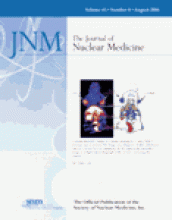TO THE EDITOR:
Thanks to Dr. Winfried Brenner et al., and The Journal of Nuclear Medicine, for publishing the excellent continuing education article on imaging of osteosarcoma with PET (1).
I have a correction and a comment. The brief discussion of non–18F-FDG PET tracers leaves the reader with the impression that non–18F-FDG tracers have been used only in animal studies. In fact, as the title of the authors’ reference 41 implies, studies with 13N-labeled amino acids had been performed on patients with osteosarcoma and soft-tissue sarcomas several years before the first clinical use of 18F-FDG in these tumors. Studies using 13N-(l)-glutamate included pretherapy planar imaging studies (2,3) and quantitative follow-up studies that correlated the histologic extent of residual viable tumor with changes in 13N uptake (4). A review published in 1984 included PET images of 13N-(l)-glutamate and 18F-sodium fluoride in osteosarcoma (5).
The use of amino acids natively labeled with short-lived positron emitters offered several advantages to the pediatric patient population, including rapid enzymatic synthesis, rapid tumor localization (minutes as opposed to hours with 18F-FDG), and very low radiation exposure. Unfortunately, the early enthusiasm for 13N and 11C tracers was soon dampened because of the scarcity of hospital-based cyclotrons. If PET scanners and on-site production facilities continue to proliferate, perhaps a place will be found for non–18F-FDG PET tracers for osteosarcoma.
REFERENCES
REPLY:
We appreciate the comments and additional information provided by Dr. Reiman regarding our review article on PET imaging of osteosarcoma (1).
When searching PubMed, the online service of the National Library of Medicine, for PET tracers besides 18F-FDG and 18F-fluoride ion (18F) that have been applied to osteosarcoma, we retrieved experimental studies using 18F-labeled monoclonal antibodies (2), 18F-fluoromisonidazole (3), 18F-labeled Arg-Gly-Asp (RGD)–containing glycopeptide (4,5), 3H-thymidine (3), and PETimaging of p53 transcriptional activity (6). Although we used various search terms on PubMed, the study by Sordillo et al. (7) was the only patient study we found, and the studies mentioned by Dr. Reiman did not surface. Thus, we are grateful for this information on human studies with 13N-(l)-glutamate—information that gives us a more complete overview of PET imaging of osteosarcoma.
We also would like to use Dr. Reiman’s comments on successful sarcoma imaging with 13N- and 11C-labeled compounds to encourage the application of non–18F-FDG PET tracers. When PET scanners with on-site cyclotron facilities become more ubiquitous and shipping of 18F-labeled compounds to satellite PET devices is available, both new and “old” tracers should be applied in patient studies to investigate their potential for individualized risk evaluation. The use of a PET tracer such as 13N-(l)-glutamate, 13N-methionine, 18F-fluorothymidine, 11C-acetate, 11C-verapamil, 18F-misonidazole, or 18F-annexin, to name just a few, could give detailed insight into biologic features such as amino acid metabolism, cell proliferation, multidrug resistance 1–induced chemotherapy resistance, tumor hypoxia, and apoptosis. This additional information will assist physicians in choosing the best available therapy for an individual patient and in tailoring follow-up to the specific case. Such an individualized approach will further improve patient outcome and will also allow knowledge of molecular imaging to be applied clinically and help nuclear medicine continue to evolve as a modern specialty in the fast-growing field of sophisticated diagnostic procedures.







